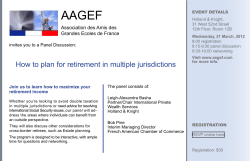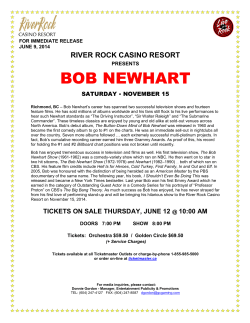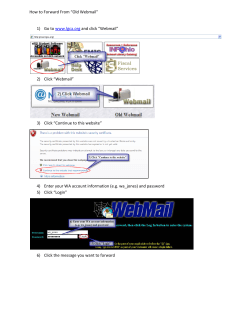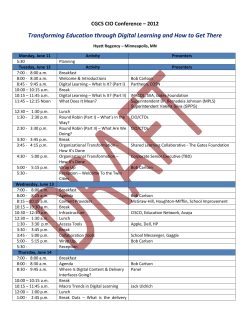
A Data Eye for the Journalist Guy
A Data Eye for the Journalist Guy By Gina VanderLoop, ROI Solutions A friend of mine in charge of a large non-profit organization sent me an article the other day from the Chronicle of Philanthropy. The article was called “How a Journalist's Eye Can Improve Fund Raising” and at its core, author Bob Levey highlighted how the world could be different if fundraisers would write more insightful visit reports. The friend said to me… “This is what we’re trying to do. It would be great if we could actually capture and store this information.” Well, I couldn’t resist with a lead-in question like that. The Full Text of the Article can be found here: http://philanthropy.com/premium/articles/v20/i08/080021 01.htm and it’s an excellent article every fundraiser should read. I agree with Bob Levey. Most (if not all) donor visit reports are skimpy and therefore not terribly useful. But I’d take his argument a step further. Not only do we need to create more comprehensive donor reports with a journalist’s eye toward fundraising strategy, but we also need to provide meaningful placeholders for this information so that we can retrieve it and use it. Since this article is university based (for a specific university), we have his education and we can add that information in: Below you’ll see the sample record we created for Bob’s Brooks Brothers-style potential donor (whom we fictitiously named Robert Johnson). We’ve entered in all of the basic information that would likely exist in the donor record prior to Bob’s visit (things like name, address, phone). We’re assuming Robert has already made some level of gift (or at least we’re assuming that the organization has already learned something about him to qualify him for a personal visit), but we can ignore the fact for the moment and come back to it later. During the visit, Robert told Bob his age and that he grew up in Mississippi (in this case, we don’t know the exact birth date, but that can be added as well if it’s known): The Basics At this point, we have only Robert’s basic record level contact information: –1– ROI Solutions, Incorporated © February 2008 ROI Solutions I 196 Boston Avenue, Suite 3000 I Medford, MA 02155 I www.roisolutions.com We also know Robert runs a major PR firm. At this point, we can add his Public Relations Firm, Incorporated (the PR Firm) as its own record to the database and create a relationship between Robert’s record and that of the PR firm. (We could also just add the PR firm as a separate address record, but this is more fun…) connected to the PR Firm comes in contact with the organization. Other Family Members? Now we add Robert’s family members to his account: both his wife and his daughter. At a later date, maybe when Jenny graduates, we can separate her off into her own record; but for now she’s part of the family record. We can now see (below) in Robert’s record an existing relationship to the PR Firm. In this case, we chose the “Employee to Employer” relationship; however, relationship types are dynamic and (in reality) it’s the client who chooses whatever relationship type makes the most sense for their organization. And since Robert said that his daughter went to the same university, we went ahead and put her information in for education: While in Robert’s records, we can link over to the PR Firm record: What else do we know? Going back to the article, we know Robert gives to the Symphony and the Museum. Okay, let’s put that into “Gifts to Other Organizations.” If we know how much he gave and when, we can add that as well (under “Gift Type,” “Method” and “Info Source”) which can be very useful. Robert’s mother (Margaret Johnson) also graduated from the university, so we created a relationship link between Robert and his mother, as well as between Jenny (Robert’s daughter) and Margaret (Jenny’s grandmother). (Note: We marked this record as “Do Not Contact” because this record really shouldn’t be used for contacts.) By adding the PR Firm as a record, we can track any time an employee or someone simply –2– ROI Solutions, Incorporated © February 2008 ROI Solutions I 196 Boston Avenue, Suite 3000 I Medford, MA 02155 I www.roisolutions.com And, of course, we noted the education in Margaret’s own record: While in Margaret’s record, we can view her relationships: And just like we did with Robert’s company, we can add Brenda’s company (Tax Law Corporation) as a separate record and create a relationship between the records: In viewing Margaret’s relationships, let’s say we happen to notice that Susan Berseth is a college friend of Margaret’s. If we click on that, we can see Susan’s relationships and, low and behold, we see that Susan Berseth is Kate Berseth’s mother. Wow. Small world. At this point, we’ve been able to enter all of the pertinent information from the first part of Bob’s visit with Robert into the donor record in a meaningful way. But we know that the anecdotal information contained in Bob’s complete narrative paints a great picture of Robert, and therefore could be useful during a future visit. So we attach the complete narrative visit notes directly to “Robert Johnson’s Comments” as a “Meeting Note.” This way, we get the best of both worlds. Because of these three primary relationships in Robert’s record, I can use the Relationship Tree to view all of the connections: We have a bit more information about Robert’s wife, Brenda L. Johnson. She’s the second name on the account within ROI, but that doesn’t prevent us from adding specific attributes to her record: –3– ROI Solutions, Incorporated © February 2008 ROI Solutions I 196 Boston Avenue, Suite 3000 I Medford, MA 02155 I www.roisolutions.com We can start to assign specific actions to be taken here for follow up or further cultivations. And these actions can be assigned to others. In this example, we made an assignment back to Bob himself to make a phone call to invite Robert to a private reception… We’re now beginning to create a full picture of Robert on file. So let’s talk about the future – the fundraising strategy part of this article. Fundraising Strategies into Actions Taking the strategy part of Bob’s article, a bird-dog fundraiser is going to try to pinpoint the best target in Robert’s record on which to base a direct ask for money. But Bob also talks about cultivation strategies that might encourage a better relationship between the organization and the potential donor before an ask is even made. There are many possible strategies here – probably too many to target for one ask, but they are all useful and should have a unique place in the database (instead of simply being added as an amorphous note to the record). Bob Levey says: Raspberry jam, not butter. Careful about his health. Must be thinking about staying vigorous and active. Probably not easy to persuade him to make a planned gift. In this case, we might keep this as a visit report narrative – in other words, we wouldn’t set up anything that specifically says “don’t approach him for a planned gift.” The absence of a project on Planned Giving would imply it. Bob Levey says: Brooks Brothers-style shirt. Says to me that he's comfortable with being establishment. Probably best to steer him toward making a gift for traditional academic areas rather than something too experimental or esoteric. Bob Levey says: Brownies for his mother. Close relationship. Might he be able to influence her to make a planned gift? Might he influence her to make an outright gift? Both? Okay, let’s put a few Solicitors in the Mother’s record: Bob Levey, our fictitious fundraiser who did the visit and wrote up these notes/article. And just because Bob is a board member (who’s not likely to do things like enter data into the database or do research), we’re going to create an account steward (the staff person) Delta Donohue on the account as well. Even though we may not record his actual style of dress in the database, there’s a nugget in here about a gift for traditional academic areas. We just happen to have such a Campaign going on in our nonprofit demo organization. Let’s call it the Annual Fund (in reality, this is controlled by the organization). –4– ROI Solutions, Incorporated © February 2008 ROI Solutions I 196 Boston Avenue, Suite 3000 I Medford, MA 02155 I www.roisolutions.com create a program within Robert’s record with a “Status of Planned” or “Cultivation” with specific and assigned actions within the project. Here’s what that could look like as an example: And let’s create a Planned Gift Project for Margaret. We will put her in reserve for the moment, because we’re not quite ready to approach her directly. Bob Levey says: His wife's career. Since he mentioned her — and it — with such obvious pride, his wife should be part of all future fundraising discussions. Maybe their career interests could be blended into a lecture series in the law school about public service. Since we’ve already put Robert’s wife (Brenda) directly into his record, we noted her account (and any associated data attributes) within her record and made sure that the salutations and household names include her name as well as his. This means that any mailings or contacts sent to this household will include Brenda’s name as well as Robert’s. Once we have a project set up (in this case one on Planned Giving — but again it could be whatever is most meaningful to you), we can start creating specific actions. Below is a specific action assigned to Delta Donohue (our wonderful staff person) to do some donor research. (Note: Action types are also dynamic to the organization). These actions are tied to ticklers and reminders, so Delta will be able to see her assignments and tasks. You can always add more actions as needed. Bob Levey says: Southern pride. He could be asked to serve on an advisory board that plans an annual colloquium to study Southern culture. If he agrees, this might be the way to get him interested before anybody prematurely asks him for a big donation. By way of demonstration, we just went ahead and put Robert on that board in our database. Notice (below) that we can stipulate effective and end-dates, as well as an automatic removal dates if appropriate. At this level, we can also assign a flag that’s specific to this record/entry if we need to track additional information. Bob Levey says: The pronunciation of "public relations." Clearly has a sense of the larger society. Could he be steered toward establishing a professorship in public affairs? Since these are specific program strategies, we can certainly go ahead and create specific projects and actions under each area just like we did in the examples above. And it’s likely in a university setting that there would be a program already defined for approaching people for a professorship. In that case, we could simply Bob Levey says: Likes art, likes jazz. One of the toughest gifts to raise is support for summer internships for painters and musicians. Maybe this is the guy. –5– ROI Solutions, Incorporated © February 2008 ROI Solutions I 196 Boston Avenue, Suite 3000 I Medford, MA 02155 I www.roisolutions.com Again, we can create a project specific to Robert in which the aim is to explore his potential support to fund summer internships (again, as a cultivation item) just like we did in the examples above. At the very least, we want to track Robert’s interests in our demographics section, because that will give us the ability to set up demographic flags in ways that are meaningful and specific to the organization. We can create a generic category called “interests,” or we can narrow it as we did below: Bob Levey says: Learning Russian. Graduate students who want to attend professional conferences often can't do so because travel costs are so daunting. Underwriting conference costs for one or two students might get this prospect into the fund-raising slipstream slowly and comfortably — especially if the students report back to When we step back and look at Robert’s record in Revolution, we realize that we have a lot of information on him (notice the filled in check boxes going down the left hand tree-view navigation): him in Russian. Ditto from the sections above on tracking this information. We can put the full text of Bob’s Fundraising Strategies into the “Research Notes” section within Robert’s record which is viewable and printable. As we did above, Bob’s strategies can also go into the notes section, but since we consider them “strategic,” we felt they were perhaps more appropriate here. Notice that access is restricted to only those members in the Major Donor Group. By limiting access to Robert’s record, we provide a little extra security while we’re thinking about possible approaches with this donor. –6– ROI Solutions, Incorporated © February 2008 ROI Solutions I 196 Boston Avenue, Suite 3000 I Medford, MA 02155 I www.roisolutions.com Constructing a Big Picture View Using the ROI Profile Builder, I can set up a view for this record and select the items and order in which I want to see them. This view can also be printed and given to people as a more comprehensive visit report – or as information leading into a follow up visit/meeting with this donor. Managing the Approaches Actually entering data into a database isn’t the problem. The challenge for nonprofit organizations is to create a database that provides logical placeholders for all the vital information you’re able to collect. Ultimately, it’s the access to your vital information that matters, because we only put data into a database in order to do something valuable with it later on. Enter the ROI Revolution Major Gifts Console. Throughout the set up of this record and its associated data attributes, we’ve made specific projects and actions for people to take as examples. Those people (“solicitors”) can login and view specific actions that have been assigned to them in this process. Here is Bob’s Action Items as an example: –7– ROI Solutions, Incorporated © February 2008 ROI Solutions I 196 Boston Avenue, Suite 3000 I Medford, MA 02155 I www.roisolutions.com And here is Delta Donohue’s: Both of these individuals will get reminders on their actions. This console also gives you the ability to set up delegates for other solicitors. This is particularly useful for some solicitors (board members) who may not have (or want) direct access to an organization’s database. In such cases, “delegates” can be set up to manage the actions on their behalf, even though the board member may, in fact, be the one to do the action. In addition, since we are The Boss in this fictitious world, we can view their action items as well. We can also see the list of solicitors and how many accounts they are responsible for (by “Role” or Solicitor Type) and hyperlink over to their accounts. Conclusion Bob Levey is right, certainly. But having a more complete donor report itself isn’t enough and never has been — though it’s a step in the right direction. It’s not just a matter of the way we might be considering our potential donors; just as often, the major challenge is having to deal with a database that can’t store unlimited and disparate information in a meaningful way. With most databases, if “certain fields” don’t exist, you’re told to create “User Defined Fields” which just end up being tacked on here and there and used inconsistently. And if that’s the way you’re storing your data, you might as well unplug all your desk lamps too, because you’re just not seeing the whole picture. With Revolution On-Line, we allow you to see everything, so you can find what you’re looking for. ### And since all of this data resides back in the database, we can extract it in other ways as well, such as through ad hoc queries or canned reports. But part of the beauty of an online system like ROI ‘s Revolution On-Line is that many of the necessary management tools can be created directly within the system itself, thereby making the management aspect of donor contacts and follow-up far more dynamic and interactive. Bob Levey; How a Journalist’s Eye Can Improve Fundraising, Chronicle of Philanthropy Vol #20 Issue #08 and on the web @ http://philanthropy.com/premium/articles/v20/i08/080021 01.htm See also: Major Gifts: A Database Primer for ROI Users, September 2007, ROI Solutions. –8– ROI Solutions, Incorporated © February 2008 ROI Solutions I 196 Boston Avenue, Suite 3000 I Medford, MA 02155 I www.roisolutions.com
© Copyright 2025










